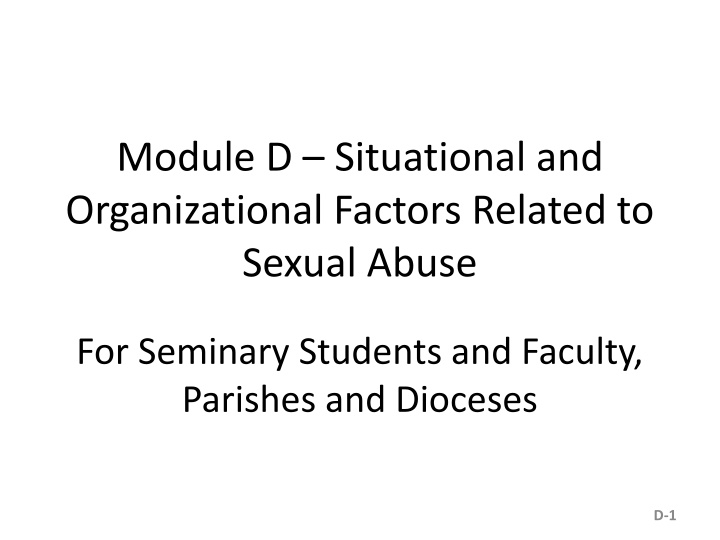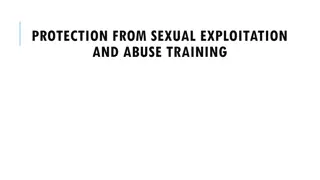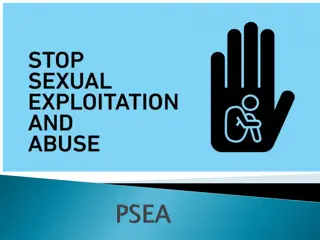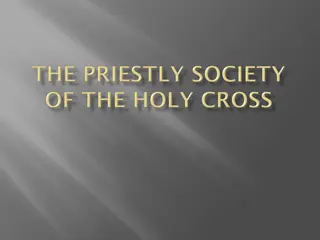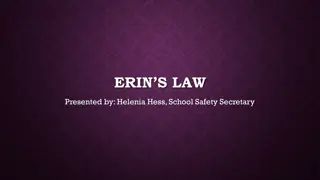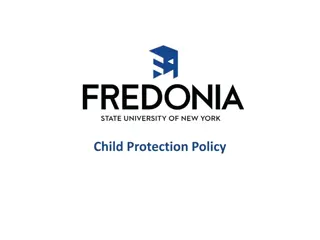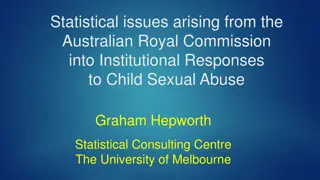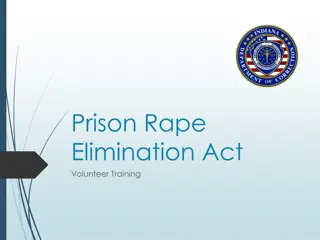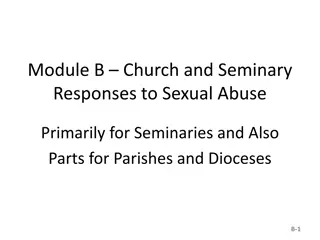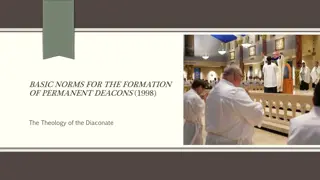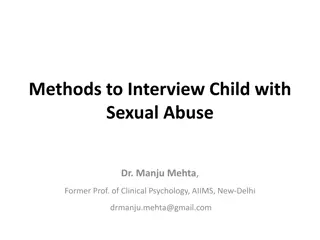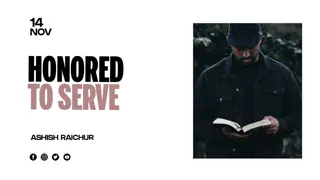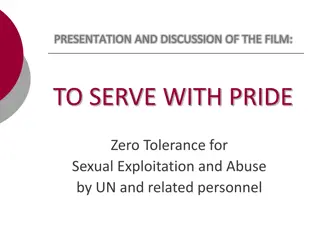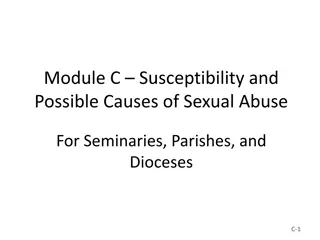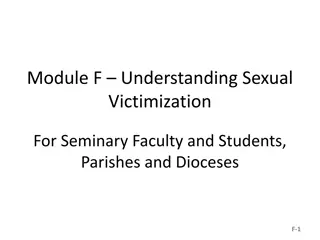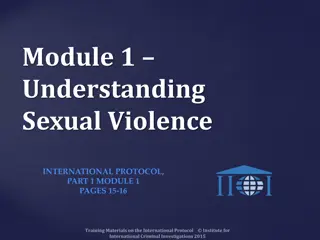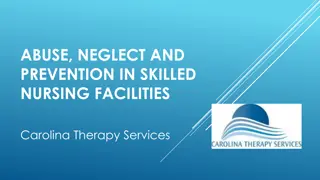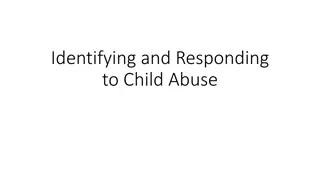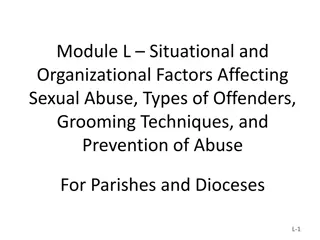Situational and Organizational Factors in Sexual Abuse by Catholic Priests
The content discusses situational and organizational factors related to sexual abuse involving seminary students, faculty, parishes, and dioceses. It covers settings and circumstances of sexual abuse, including locations where victims first encountered abusive priests. Data reports from the United States Conference of Catholic Bishops are referenced, shedding light on the causes and contexts of sexual abuse by priests between 1950 and 2010. The information is essential for understanding and addressing issues of sexual abuse within the Catholic Church.
Download Presentation

Please find below an Image/Link to download the presentation.
The content on the website is provided AS IS for your information and personal use only. It may not be sold, licensed, or shared on other websites without obtaining consent from the author.If you encounter any issues during the download, it is possible that the publisher has removed the file from their server.
You are allowed to download the files provided on this website for personal or commercial use, subject to the condition that they are used lawfully. All files are the property of their respective owners.
The content on the website is provided AS IS for your information and personal use only. It may not be sold, licensed, or shared on other websites without obtaining consent from the author.
E N D
Presentation Transcript
Module D Situational and Organizational Factors Related to Sexual Abuse For Seminary Students and Faculty, Parishes and Dioceses D-1
Situational and Organizational Factors Related to Sexual Abuse of Minors by Catholic Priests D-2
Main Sources of Data Reports presented to the United States Conference of Catholic Bishops by the John Jay College Research Team, The City University of New York* The Causes and Context of Sexual Abuse of Minors by Catholic Priests in the United States, 1950-2010, March, 2011 The Nature and Scope of Sexual Abuse of Minors by Catholic Priests and Deacons in the United States, 1950- 2002, February 2004 * The two reports are based on data supplied by 97 percent of U.S. archdioceses and dioceses on all clergy accused of sexual abuse of minors D-3
I. Situational Factors: Settings and Circumstances of Sexual Abuse D-4
Settings Where Victims First Met Priests Who Abused Them Location of First Meeting % Male Victims % Female Victims A. Church/Parish Related 64.8 58.9 B. School/Teacher 15.1 13.6 C. Home of Victim or Relative of Victim 4.9 14.2 D. Other Institutions 7.8 7.3 E. Other 7.1 6.2 Total 99.7 100.2 * % Based on Nature and Scope and victim survey of 7,142 boys and 1,762 girls. D-5
A. Church/Parish Related Location of First Meeting % Male Victims % Female Victims At Mass 33.8 27.1 At an Altar Service/In the Rectory 12.3 10.7 In the Parish 17.5 19.9 Home of Cleric 0.8 0.7 Choir 0.4 0.5 Total 64.8 58.9 D-6
B. Teacher/School Related Location of First Meeting % Male Victims % Female Victims Teacher (up to grade 6) 0.7 1.3 Teacher (grades 7-8) 0.9 1.4 Teacher (grades 9-12) 8.4 4.9 Sunday/Parish School 0.8 0.9 Other School 2.4 4.9 Seminary Faculty/Administrator 1.9 0.2 Total 15.1 13.6 D-7
C. Home of Victim or Relative of Victim Location of First Meeting % Male Victims % Female Victims Home of Victim/Social Function with Victim s Family 4.5 12.7 Cleric is Relative 0.4 1.5 Total 4.9 14.2 D-8
D. Other Institutions Location of First Meeting % Male Victims % Female Victims Boys Club/Youth Recreation 4.9 5.6 Work in Hospital 0.8 0.7 In Jail/Prison/Youth Offender Residence 1.2 0.1 Orphanage 0.9 0.9 Total 7.8 7.3 E. Other Location % Male Victims % Female Victims Other 7.1 6.2 D-9
Physical Locations of Abuse Location of Abuse % Male Victims % Female Victims A. Church/Parish Related 65.8 62.7 B. Residences 59.0 47.0 C. Other Locations 30.5 25.4 Note well: Clergy sexual abuse occurs in multiple settings Most frequently it is in church-related locations A wide range of residential contexts are used Other public and private venues also are exploited D-10
A. Church/Parish Related Locations of Abuse % Male Victims % Female Victims Cleric s Home/Parish Residence 36.3 30.7 In Church 14.2 12.9 In School 8.2 11.4 Cleric s Office 6.2 7.6 Congregate Residence 0.6 0.1 Total 65.8 62.7 D-11
B. Residences Location of Abuse % Male Victims % Female Victims In Victim s Home 10.9 10.4 Vacation House 9.9 5.0 In Other Residences (Friends, Family) 1.0 0.8 21.8 16.2 (Following residences also included in A above.) Cleric s Home/Parish Residence 36.6 30.7 Congregate Residence 0.6 0.1 Total 59.0 47.0 D-12
C. Other Locations Location of Abuse % Male Victims % Female Victims In a Car 8.5 8.4 In a Hotel 7.0 3.6 On Outings Camp, Park, Pool 7.8 5.7 Retreat House 1.2 1.5 In the Hospital 0.7 0.7 Other 5.3 5.5 Total 30.5 25.4 D-13
Circumstances/Timing of Abuse Circumstances/Timing % Male Victims % Female Victims A. Church/Parish Related 27.1 27.8 B. Social Event/Other Recreation 42.2 40.8 C. Other 14.4 16.2 Total 83.7 84.8 * Categories are not mutually exclusive, as victims may have experienced abuse in more than one location. D-14
A. Church/Parish Related Circumstances/Timing % Male Victims % Female Victims Visiting/Working at Cleric s Home/Rectory 13.2 13.1 Church Service (Before, During, After) 8.0 3.4 School Hours 4.2 8.2 During Reconciliation 1.3 2.8 Church Service, Training 0.4 0.3 Total 27.1 27.8 D-15
B. Social Event/Other Recreation Circumstances/Timing % Male Victims % Female Victims During Social Event 17.8 21.9 During Travel 14.0 7.2 Cleric Visited Home of Victim 2.9 7.4 During Sporting Event 4.5 2.5 Outings 3.0 1.8 42.2 40.8 D-16
C. Other Circumstances/Timing % Male Victims % Female Victims During Counseling 6.3 7.1 Hospital Visit 0.1 0.2 During a Retreat 0.8 1.4 Other 7.2 7.5 14.4 16.2 D-17
II. Organizational Factors Related to Abuse D-18
Priests Primary Duty or Role at Time of Abuse Duty or Role % Male Victims % Female Victims A. Pastoral/Parish Related 77.2 80.2 B. Other Clerical Role 6.7 5.6 C. School/Teaching Role 8.7 5.6 D. Other 7.4 8.6 Total 100.0 100.0 * Based on Nature and Scope victim surveys of 7,864 boys and 1,863 girls. D-19
A. Pastoral/Parish Role Duty or Role % Male Victims % Female Victims Associate Pastor 42.2 42.1 Pastor 25.0 26.0 Resident Priest 8.8 10.9 Saying Mass 1.2 1.2 Total 77.2 80.2 D-20
B. Other Clerical Role Duty or Role % Male Victims % Female Victims Bishop, Vicar, Chancellor, Cardinal 0.4 0.2 Seminarian/Seminary Administration/Faculty 1.9 1.4 School/Institutional Administrator 1.0 1.7 Chaplain 2.8 2.1 Worked in Hospital 0.6 0.2 Total 6.7 5.6 D-21
C. School/Teaching Role Duty or Role % Male Victims % Female Victims Teacher (up to grade 6) 0.2 0.1 Teacher (grades 7-8) 0.3 0.4 Teacher (grades 9-12) 7.2 4.2 Guidance Counselor 0.9 0.6 Catechism Teacher 0.1 0.3 Total 8.7 5.6 D-22
D. Other Duty or Role % Male Victims % Female Victims Boys Club/Recreation 1.6 1.2 Cleric is Relative 0.3 1.0 Other 5.5 6.4 Total 7.4 8.6 D-23
Additional Observations Related to Situational and Organizational Circumstances, 1 To prevent or identify abuse, education of potential victims, potential abusers, and potential guardians is essential since abuse can occur when these three factors exist: a person who is motivated to commit the act of abuse a potential victim lack of a capable guardian A capable guardian is one who has oversight and awareness of a child s wellbeing, most often parents D-24
Additional Observations Related to Situational and Organizational Circumstances, 2 Precautions to lessen conditions for sexual abuse to occur during meetings with children: Do not meet alone with a child in a closed room without windows Have two adults present when meeting a child whenever possible Have cameras installed in rooms where meetings take place Keep in mind: An abuser is likely to be considered a very good person Many priests who were accused of sexual abuse were in other ways excellent in carrying out their ministry D-25
Summary of Situational and Organizational Factors Related to Sexual Abuse of Minors Situational Factors: Settings and Circumstances of Sexual Abuse - Settings Where Victims First Met Priests Who Abused Them - Physical Locations of Abuse - Circumstances and Timing of Abuse Organizational Factors Related to Abuse - Priests Primary Duty or Role at Time of Abuse Additional Observations Related to Situational and Organizational Circumstances D-26
Discussion Questions Considering the settings and locations where abuse took place, what precautions should priests and other church leaders take about where they meet young people? Taking into account the circumstances and timing that were most common when abuse was perpetrated, what instructions should be given to those who are or soon will be serving in ministry? What other safeguards should be considered in discussions relative to the places and situations where abuse has occurred ? Link to USCCB http://www.usccb.org/issues-and-action/child- and-youth-protection/charter.cfm D-27
Prepared by: Sister Katarina Schuth, O.S.F., St. Paul Seminary School of Divinity, University of St. Thomas Technical Associate: Catherine Slight Consultants: Dr. Karen Terry and Margaret Smith, John Jay College of Criminal Justice, authors of major studies on sexual abuse for the USCCB; Dr. Mary Gautier, Center for Applied Research in the Apostolate D-28
